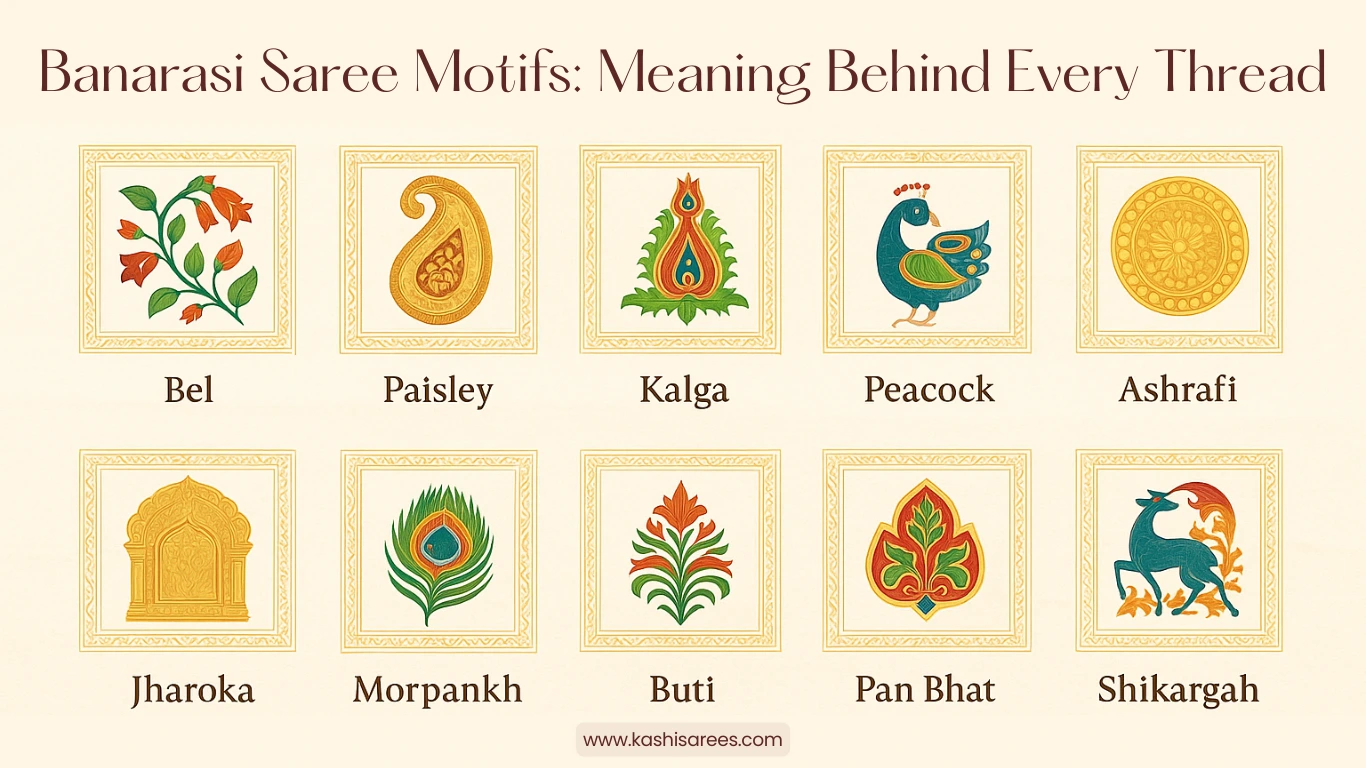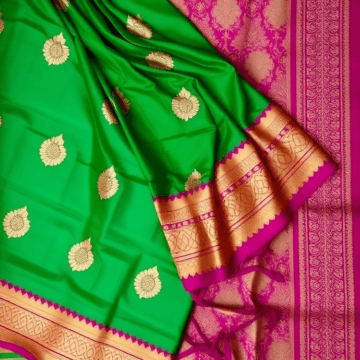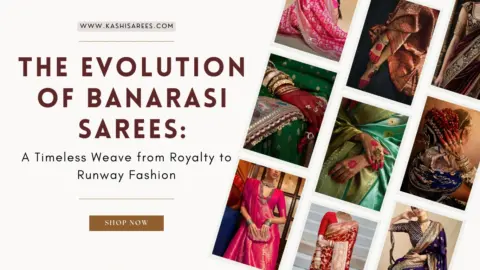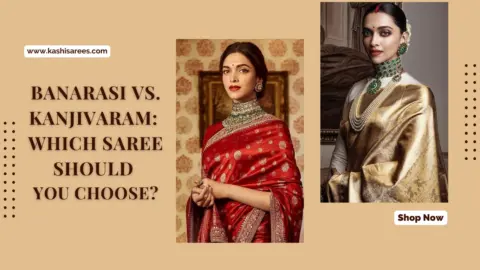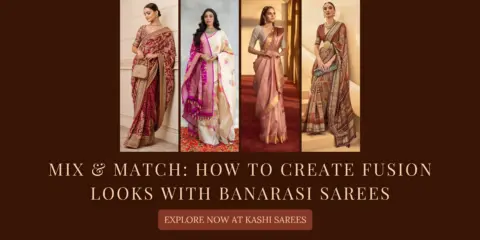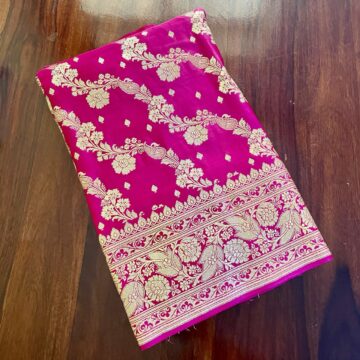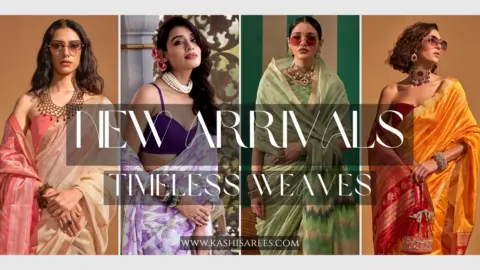Banarasi sarees are more than just beautiful garments—they are woven stories brought to life through intricate Banarasi Saree Motifs. Each motif carries deep cultural meaning, drawing inspiration from India’s rich heritage of flora, fauna, architecture, mythology, and Mughal artistry. These motifs are not just decorative—they’re symbolic threads connecting tradition, emotion, and timeless elegance.
At Kashi Sarees, we believe that understanding the meaning behind these motifs doesn’t just enhance appreciation—it deepens the emotional connection between the saree and the wearer.
In this blog, we decode the most iconic Banarasi motifs, so you’ll never look at your saree the same way again.
1. Kalga & Bel: Mughal-Inspired Elegance
Kalga
A curved, teardrop-shaped motif resembling a paisley but more upright and regal.
Origin: Mughal gardens and Islamic architectural domes.
Symbolism: Nobility, refinement, and strength in femininity.
Often used alongside bel in all-over (jaal) designs.
Bel
A winding vine pattern, often intertwined with flowers and foliage.
Symbolism: Fertility, growth, harmony with nature.
Common in borders and pallu designs.
Style Note: Kalga-bel jaals are typically found in bridal Banarasis, especially in red, maroon, and gold tones.
2. Paisley (Kairi or Ambi): The Eternal Tear of Life
Perhaps the most globally recognized Indian motif.
Origin: Ancient Persia, carried into India through Mughal design.
Symbolism: Life, fertility, and the divine feminine.
The curve represents continuity and abundance.
Paisleys are often arranged in symmetric rows or scattered like droplets across the body of the saree. They are timeless and work well for both traditional and contemporary looks.
3. Jaal: The Grand All-Over Design
Jaal means “net” or “web,” and refers to an intricate all-over pattern of flowers, vines, or geometric repeats.
Symbolism: Opulence, interconnectedness, and celebration.
Used in wedding trousseaus and regal ensembles.
Tip: Jaal Banarasis are best worn for grand occasions due to their rich texture and detailing.
4. Shikargah: The Royal Hunt Scene
One of the most complex and unique motifs in Banarasi weaving.
Depicts: Scenes of hunters, animals, trees, and royal processions—woven like a tapestry.
Symbolism: Valor, aristocracy, power, and storytelling.
Often seen in vintage heirlooms and museum-worthy sarees.
A Shikargah Banarasi is a collector’s dream—ideal for legacy wardrobes.
5. Peacocks (Mor): National Pride in a Pattern
India’s national bird, the peacock is a widely loved motif.
Symbolism: Beauty, grace, royalty, and divine connection (Lord Krishna and Saraswati).
Usually found on pallus, but also in border detailing and buti work.
Peacocks add a festive flair and are perfect for celebrations, pujas, and temple weddings.
6. Lotus (Kamal): Purity and Rebirth
The lotus is a sacred flower in Indian culture and often appears in pallu or border motifs.
Symbolism: Enlightenment, purity, rebirth from darkness.
Found in both Hindu and Buddhist art traditions.
Lotus motifs give a spiritual aura and suit both religious and bridal occasions.
7. Elephants, Deer & Animal Motifs: Strength, Grace & Serenity
Often found in Shikargah or standalone motifs.
Elephant (Hathi): Power, wisdom, stability.
Deer (Mriga): Grace, speed, gentleness.
Parrots (Tota): Love, communication, and companionship.
Animal motifs are a nod to India’s deep bond with nature and are ideal for those who cherish artisanal detail.
8. Geometric Patterns: Modernity in Tradition
Checks (Chowkdi), Diamonds (Heera), Zigzags: Add a modern and structured touch to traditional designs.
Symbolism: Balance, symmetry, and cosmic order (mandala energy).
Used in borders or full body designs to bring elegance without excess.
Perfect for professional settings, formal dinners, or minimalist styling.
9. Meenakari Work: A Pop of Color
Though not a motif per se, Meenakari refers to multicolored thread work added to motifs—usually flowers or leaves.
Symbolism: Celebration, joy, and festivity.
Adds vibrancy to otherwise gold-and-silver zari designs.
A Meenakari Banarasi is ideal for events where you want tradition with a playful twist.
10. Buti & Boota: Tiny Dots of Luxury
Buti: Small single motifs
Boota: Slightly larger, often floral or paisley-based
Spread across the body of the saree in repeat patterns.
Symbolism: Subtlety, elegance, and grace.
Buti sarees are ideal for workwear, pujas, or understated events.
Why Motifs Matter: Beyond Beauty
Understanding the motifs in your Banarasi saree helps you:
Choose the right design for your occasion or personality
Tell a story through your outfit
Pass down a garment with deeper emotional value
Support the artistry of weavers who embed culture in every thread
What Your Saree Says About You
| Motif Type | Best For | Symbolizes |
|---|---|---|
| Kalga-Bel Jaal | Weddings, Receptions | Grace, prosperity, royal elegance |
| Paisley | Festive events, parties | Abundance, beauty |
| Shikargah | Legacy or bridal wardrobes | Power, history, storytelling |
| Lotus & Peacock | Temple visits, religious events | Purity, spirituality, celebration |
| Buti | Everyday elegance, office wear | Subtle charm, tradition |
Final Thoughts: Every Saree Has a Story
At Kashi Sarees, we don’t just create beautiful sarees—we preserve cultural meaning and help you wear something that carries generations of artistry and emotion. The next time you drape a Banarasi, know that you’re wearing a symbol, a story, and a celebration of India’s soul.
Explore motif-rich Banarasi sarees at www.kashisarees.com
Tell us your favorite motif: Tag @_kashisarees and use #MyKashiMotif to be featured!
#KashiSarees #BanarasiMotifs #DecodingDesigns #HandloomHeritage #SareeStory #IndianArtInTextiles #CulturalWeaves #MyKashiMotif #BanarasiSymbolism #FromThreadToMeaning


